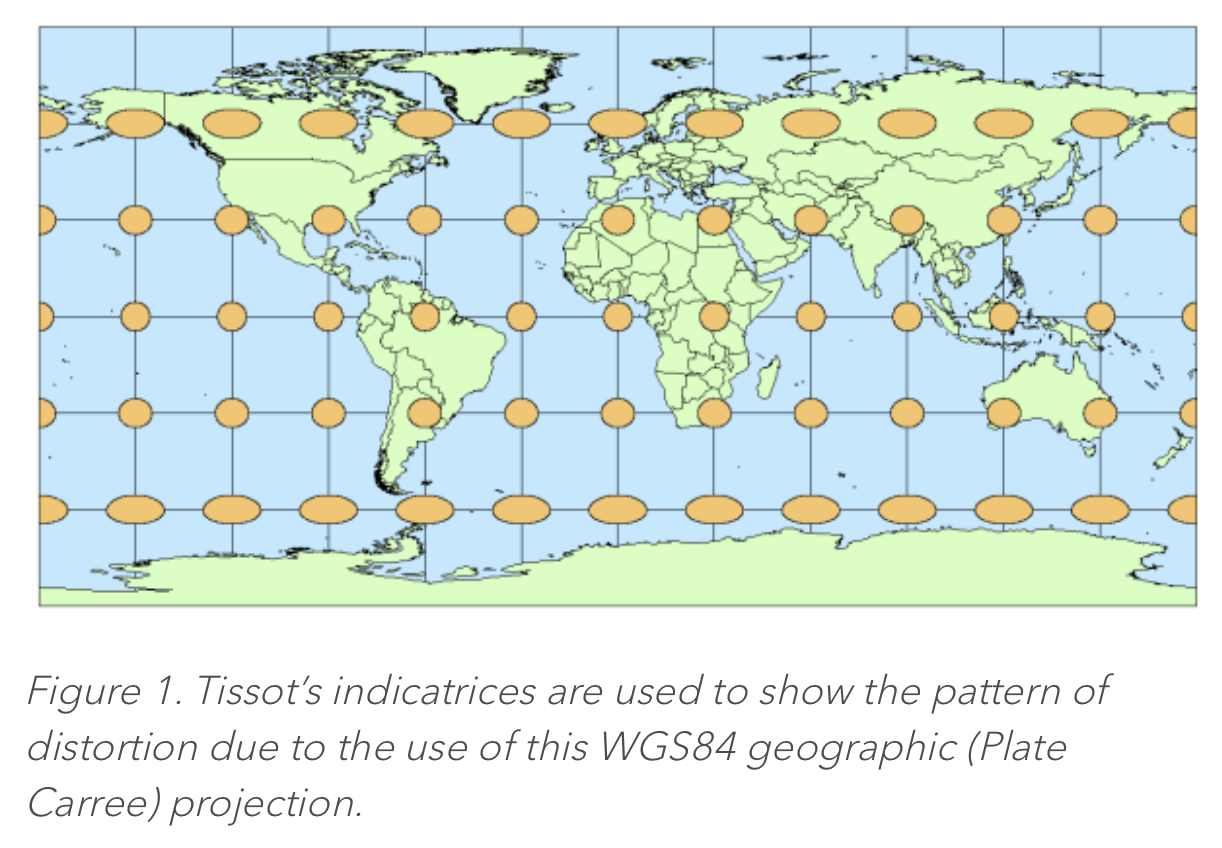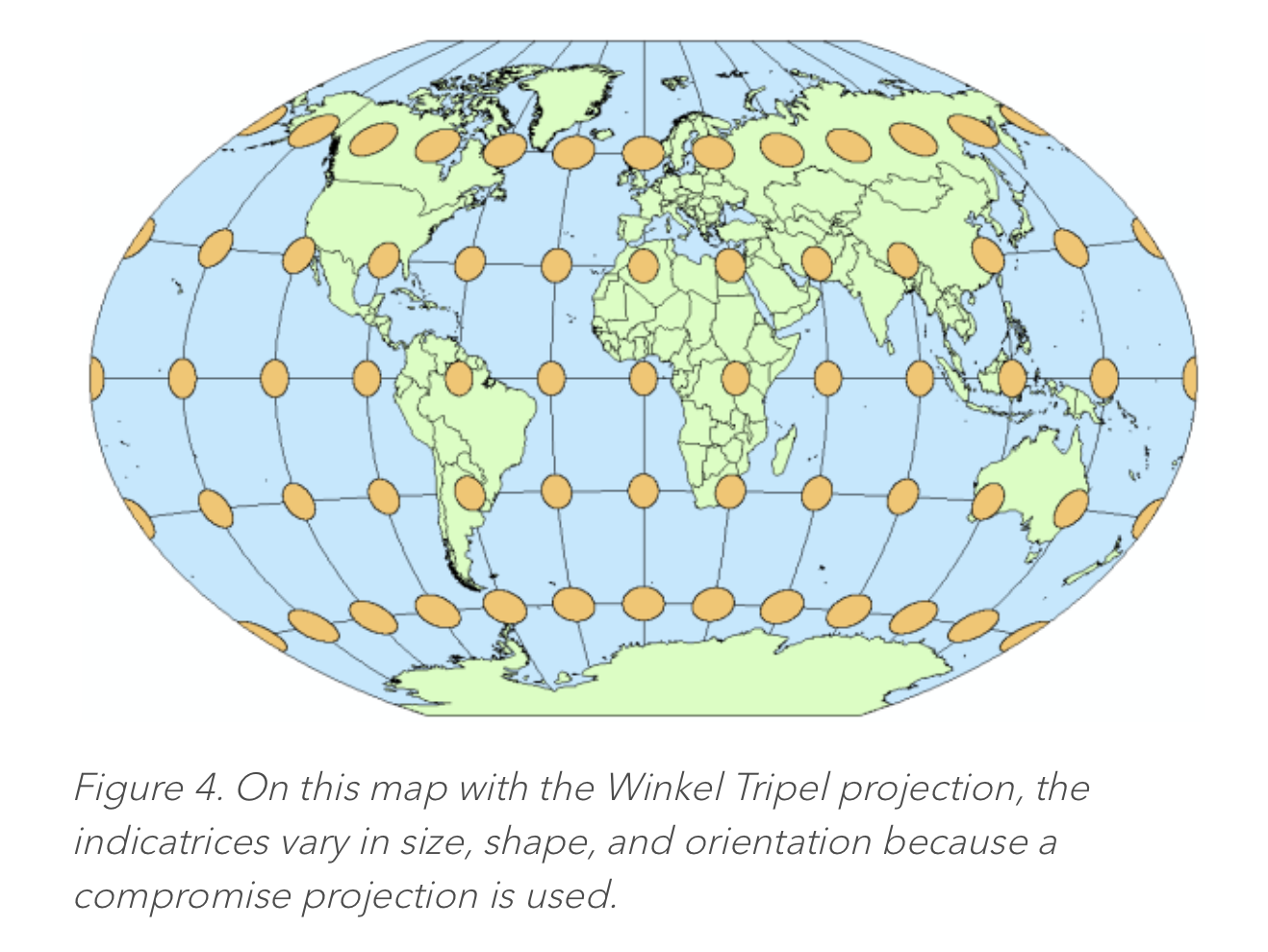Page History
...
- Note that the elliptical perspective of the EWA algorithm for swath data is quite similar to the Tissot Indicatrix ellipse of earth-data-to-flat-map projections – which shows the east-west and north-south angular distortion of a projection. There will be more discussion on this later in “off-label” applications of the EWA algorithm. [Application of EWA for grids would not involve multiple rows-per-scan of swath data acquisition, rather referring to just one row of projected data per step through the rows (rows-per-scan = 1)].
- In fact, even within the EWA algorithm, there is the elliptical area of the "sample-spot", and there is a Tissot ellipse of projection stretch (distortion) of the sample spot to a flat-earth grid. The algorithm does not particularly focus on these two sources of elliptical coverage separately, but simply computes an ellipse of coverage from the source data to the target grid.
Expand title More details... - This article provides a good introduction to Tissot's Indicatrix: https://www.esri.com/arcgis-blog/products/product/mapping/tissots-indicatrix-helps-illustrate-map-projection-distortion/
The orange ellipsoids above represent a “unit perimeter/sweep of the scale-factor vector” at each selected point. Tissot’s work proved that the shape of the unit perimeter was always an ellipse. I believe also that there is always a quadratic mapping between the ellipses at corresponding points in the two projections – another, but different “ellipse of influence” between the source and target grids. This is what the EWA algorithm uses – the unit perimeter of scale-factor as an “area of influence” from a source data point to the target projection. It computes the parameters for an ellipse in the target projection, based upon cell delta mapping/location values between the source and target grids.
For forwards projection, the source data is processed forwards to the target grid by calculating the target projected location and “ellipse of influence” for each source cell. At the end, each target cell has potentially multiple source cells that map to the target cell. The algorithm calculates a weighted average of all source cells that map to a given target cell. It calculates during the processing of source data points, the target points of reference, the weighted-values accumulated as the numerator, and the weights themselves summed as the denominator. After the source data is processed, the end results is the quotient of numerator to denominator values per target grid cell.
Overview and Discussion
Overview and Discussion
- At its core, the EWA algorithm looks at the cell-to-cell delta in source to target cell mapping, both along and across track. These deltas are used to compute the parameters for a quadratic equation defining an “ellipse of influence” from a source cell to one or more target cells.
- The “ellipse of influence” is used both to compute which target cells are affected by a source cell – a bounding box to the ellipse of influence – and to compute a weighting factor for a weighted averaging of source cells per target cell. The weighting is defined in terms of the distance of the source cell center location to the target cell center (radius of the ellipse). Those source cells closer to the target cell are weighted more heavily than a simple linear cell-to-cell distance.
The “ellipse of influence” provides an important technique for calculating the area of influence, in the target grid. It is an efficient way of finding target cells when forward projecting the source data grid to the output grid. This permits a reasonably efficient “forward navigation” approach, versus more typical reverse projection algorithms.
- For forwards projection, the source data is processed forwards to the target grid by calculating the target projected location and “ellipse of influence” for each source cell. At the end, each target cell has potentially multiple source cells that map to the target cell. The algorithm calculates a weighted average of all source cells that map to a given target cell. It calculates during the processing of source data points, the target points of reference, the weighted-values accumulated as the numerator, and the weights themselves summed as the denominator. After the source data is processed, the end result is the quotient of numerator to denominator values per target grid cell
- At its core, the EWA algorithm looks at the cell-to-cell delta in source to target cell mapping, both along and across track. These deltas are used to compute the parameters for a quadratic equation defining an “ellipse of influence” from a source cell to one or more target cells.
- The “ellipse of influence” is used both to compute which target cells are affected by a source cell – a bounding box to the ellipse of influence – and to compute a weighting factor for a weighted averaging of source cells per target cell. The weighting is defined in terms of the distance of the source cell center location to the target cell center (radius of the ellipse). Those source cells closer to the target cell are weighted more heavily than a simple linear cell-to-cell distance.
- The “ellipse of influence” provides an important technique for calculating the area of influence, in the target grid. It is an efficient way of finding target cells when forward projecting the source data grid to the output grid. This permits a reasonably efficient “forward navigation” approach, versus more typical reverse projection algorithms.
Anti-aliasing Filter
- An important but not always evident aspect of the EWA algorithm is a further adjustment of the weighting factors to implement a gaussian filter to the projection processing. The gaussian filter is important to minimizing the possible aliasing and moiré effects when down-sampling a larger array of source data to a smaller set of target data.
Expand title More details... - The topic of aliasing and moiré effects in digital image processing is complex. In brief, and perhaps unsatisfyingly so, anytime you digitize at a specific resolution, or "down-sample" from a higher resolution to lower resolution, it is possible to introduce patterns of imaging that suggest lines or curves that are not present in the original or source image.
- Here is one article that describes the effect, both in terms of audio sampling (where I first encountered this) and in video sampling: https://matthews.sites.wfu.edu/misc/DigPhotog/alias/index.html. (That is from a physics professor at Wake-Forest U., in North Carolina. An interesting site, and not a bad explanation of what is happening).
...

